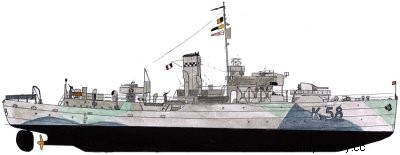
Dates
 commissioning date:
commissioning date:
 expiration date :
expiration date :
Constructor :
United Kingdom

Users :
 Royal Navy
Royal Navy
 Canada
Canada
 usa
usa
 Norway
Norway
 France
France
 Yugoslavia
Yugoslavia
Categories
 Corvette Escorts ASM
Corvette Escorts ASM
Main Features
 Displacement :900 t. Default - 1245 t. Full Charge
Displacement :900 t. Default - 1245 t. Full Charge
 Dimensions:62.5 m long, 10.11 m wide, 4.14 m draft .
Dimensions:62.5 m long, 10.11 m wide, 4.14 m draft .
 Speed :16.5 knots.
Speed :16.5 knots.
 Propulsion :2 propellers
Propulsion :2 propellers
 Power :2750 hp
Power :2750 hp
 ENGINES :1 propeller, 1 steam engine TE, 2 boilers, .
ENGINES :1 propeller, 1 steam engine TE, 2 boilers, .
 Fuel :fuel
Fuel :fuel
 Crew :86 Men
Crew :86 Men
Armaments
1 102mm cannon, 1 40mm, 2 20mm AA, 40 ASM grenades and 4 mortars.
Historical
These corvettes have gone down in history. Indissociable from the arduous struggle that brought the Royal Navy to U-Boats in the Atlantic, in the Arctic, in the Mediterranean and even in the Indian Ocean or on African coasts, the "flower" type ships, bearing indeed the name of a thousand and a familiar plant species of gardens -we know the slightly "cliche" passion of the British for gardening- have also been formidable guard dogs throughout time, operating with great efficiency thanks to their intrinsic qualities and a weaponry modest but well adapted.
First of all these ships make direct reference to the earlier "flowers" developed in 1916-17 to deal with the threat of Kaiser submarines, notices whose silhouette evoked the standard cargoes of the time to better bern the U's -Bootes. Those from 1940 are quite different in the sense that they furent built exclusively in civilian shipyards, used to producing large fishing trawlers, Thoniers or whalers, in order to relieve military shipyards and arsenals, which had long exceeded their capacity maximum. They were singular to be based on the model of a civilian vessel, the famous Greenock whaler, the Southern Pride of the Smith shipyard serving model, extended by 9 metres. This type of vessel was indeed renowned for its great sturdiness and very good holding in the formidable sea conditions of the Great North, its "natural" adaptation to this form of hunting the "steel cetaceans" and its relative ease of construction for construction sites not trained in military technology. It is to be noted that the idea had already been tested with the "Kil" series in 1917-18.
These shipyards are thus pure according to their capacity to deliver as early as 1940 from 2 to 30 ships, strong capacity varying depending on whether one speaks of Alisa, Blyth or Ferguson compared to a monster like Harland &Wolff ( the Irish builders of the "Titanic" ). In total, 143 corvettes will be delivered by these British shipyards and 68 by the Canadian shipyards, strongly experienced in Whaling. The confidence testified to by their British, Canadian, and even French crews ( The FNFL sailors of the Aconit remain legendary for their exploits-4 were already in service aboard the "Royal" before the armistice, 9 serving under pavilion to cross Lorraine ) was if alive that 25 units were transferred to the USA, who were cruelly lacking ASM escorts in 1942 ( but classified as "cannonballs" ), strange reversal of the Lend-lease agreement...
The activity of these ships was therefore very long and very active. Certain sailors claim to have even tracked Type XXI U-Boats in February 1945. Slightly quick, they were concerned about the speed of the convoy, the latter traveling at 10-11 knots, they could barely turn around. There were many differences from one ship to another (propulsion, electrical installations, ventilation, keels or ballasts, armament, antennas, asdics… ). However, 32 ships sunk during these missions.
From 1942 and up to 1944 a variant of these ships appeared, concerning mainly Canadian shipyards. These "modified corvettes" had a new hull shape, a taller and better adapted superstructure, a huff-duff trigonometric tracking antenna and better DCA. There have been but 2 losses, the Trentonia and the Merritonia in 1945.
